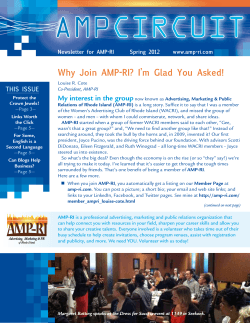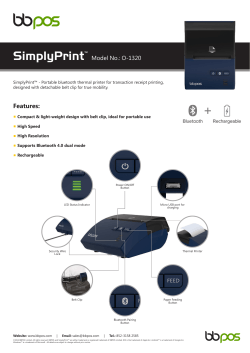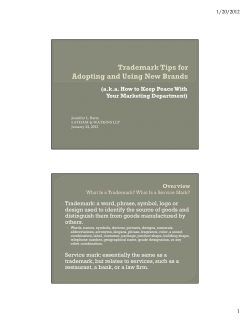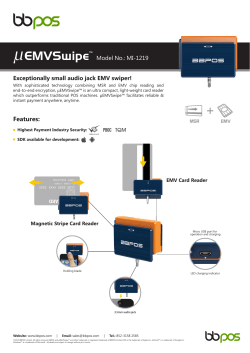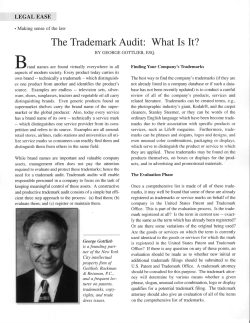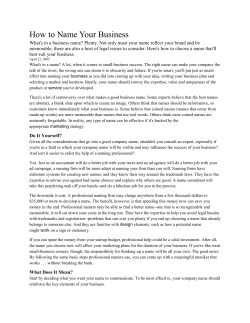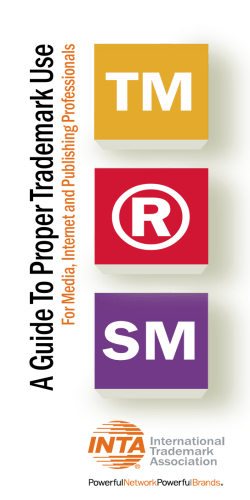
Chopped Podcast Blogging Tips â Copyright and Trademark
Chopped Podcast Blogging Tips Copyrighting and Trademarking your Food Blog Here are some of the tips from the Chopped Podcast episode #9, interview with attorney Mark Leonard. General Legal Topics that Food Bloggers should be aware of: 1. Partnerships: If you decide to partner with someone else, spend a minute or two talking about the status of your relationship. Outline what the expectations are is an important first step so everyone is on the same page. 2. Hiring a web developer: be sure you know who owns the site. If you hire a friend or a family member to design your site — or even if you hire a pro — make sure you have a contract that specifies that you own the blog and its contents. 3. Sponsored Posts: If you get a deal from a brand to do a sponsored post, it’s important to have an attorney look over the contract. If you’re promoting their product and that company is accused of trademark infringement, you can be liable for it as well. Making sure there’s an indemnification clause in the contract can cover your bases. A contract with for a sponsored post with a brand can include copyright information for your posts too. If you create a blog post for a brand, you need to know who is going to own the post, the recipes, and the photos when it’s done. Exclusivity is another issue to address. Brands may want you to work exclusively with their brand and not with competing brands for a certain period of time. Having an attorney review your contract before signing is good business practice. 4. General liability insurance: Some business insurance policies have an exclusion for intellectual property. Be sure to talk with your insurance agent if you’re getting to the point that you’re concerned about this. 5. Blog as Business Entity: The advantage of a business entity – typically an LLC or S Corp – is it protects the individual owners of the company under certain circumstances. If you’re looking at some kind of legal dispute, if your blog is a business entity then your personal assets are not at risk. There are also a lot of tax implications, so talk to your tax professional about the advantages and disadvantages. Also be aware that if you choose a legal entity there are requirements from the state – such as annual filings to the secretary of state. Each state has different requirements. Some of this can be done online which makes this process easier. 6. Privacy Policy: If you have a newsletter signup or any e-commerce on your site (cookbooks or t-shirts for sale), you need to have a privacy policy to disclose what is being done with the information collected from the user. Spell out what information you’re collecting and who will have access to it. Intellectual Property 101 1. Copyright — The content on your site – photos, the text – that is potentially protectable under copyright. There can be areas of overlap between copyright and trademark. For example, if it’s a short name or a phrase, you’re talking about trademark. Something more extensive and/or more artistic, you’re talking about copyright protection. Copyright protection lasts whether you continue to use the copyrighted item (such as a logo) or not. 2. Trademark — Your business name is something you would want to register a trademark for. Trademark rights only exist as long as the service is offered with that trademark. Every so many years you have to renew your trademark registration. Having a trademark for your blog gives nationwide notice that this name is already in use. You have trademark rights upon use of your blog name, but if a legal battle were to ensue, having your site name trademarked makes this process a lot easier (and therefore less expensive). 3. Intellectual Property – A descriptive term covering different areas of intangible property. It’s property you have rights in but it doesn’t physically exist. The different general subsets of intellectual property include copyright, trademarks, e-commerce and patent. 4. If you have a blog, you should register the trademark for your domain. Just because you can obtain the domain name (for example the name is available on Name.com) and even if you can register as a business in your state, doesn’t mean you’re not infringing on someone else’s trademark (nationally). 5. You can research your own trademark if you like. See below for more information. 6. You can also do some of your own research and work with an attorney to help you go through the trademark registration process. Steps in getting your name trademarked USPTO.gov offers a lot of tips, videos, FAQs on getting started with this process. For example, you can begin with this video that shares the basics about getting started: http://www.uspto.gov/trademarks-‐getting-‐started/trademark-‐basics Here is the basic process as defined by the USPTO: 1. 2. 3. 4. 5. 6. Determine whether you need to apply for a copyright or trademark. Identify your mark format – a standard character mark, a stylized design, or a sound mark. Identify the goods and services to which the mark will apply Search the USPTO databases to determine if a similar trademark has already been claimed. Determine your basis for filing. Consider hiring a trademark attorney to help you through the filing process You can do this application process yourself, but you can get into technical issues in trying to evaluate if another name is too similar. If you don’t talk to a trademark attorney and you proceed on your own, there’s no refund from the USPTO. The filing fees vary between $225 and $325. So, if the Trademark office comes back in response to your application and says what you’re trying to trademark is in conflict with another trademark, you’re out that money. If you choose to work with an attorney there are steps to help facilitate that process and therefore save some money: 1. 2. Make a list of other common words for website names used in your industry Make a list of other website names that could be considered similar to yours Steps in Getting Your Content Copyright Protected You can get additional information from the US Copyright Office here: http://www.copyright.gov Trademark registration for your blog name is only for the blog name. To protect the content, you have to seek copyright for your blog content. The thing is copyright protection hasn’t caught up to today’s times. If you have your site content protected under copyright today, the blog post that you publish tomorrow will not be included in that copyright protection. So the question becomes, how often should you file for copyright protection. With every blog post? With a minimum $35 filing fee, this could get expensive. So, should you consider filing quarterly? Annually? Whatever timeframe you choose, just understand that for now it’s something you will need to do regularly. Thanks for listening to the Chopped Podcast and for downloading this accompanying information sheet. We hope this short guide based on the interview with Mark Leonard has been helpful. If you liked this and would like to see more, leave a comment on the post at choppedcon.com — we love your feedback!
© Copyright 2025
